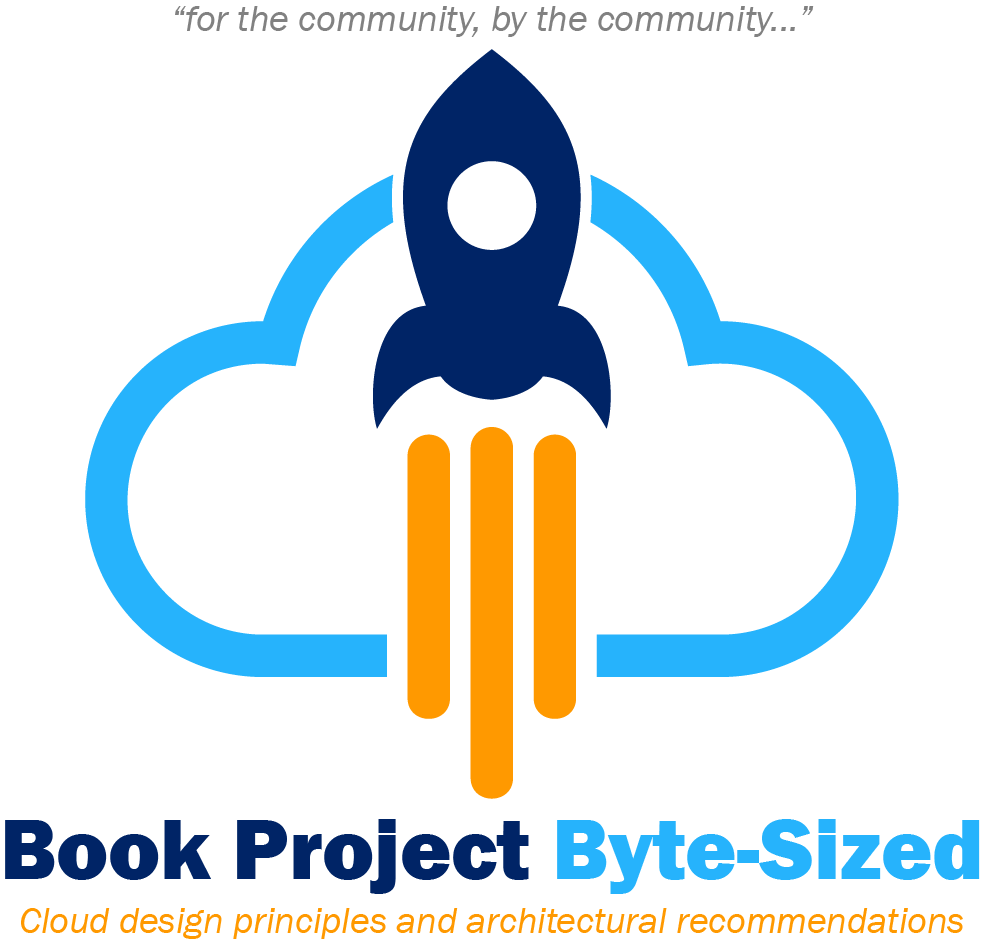The idea behind this project is simple, we’re looking for as many Cloud related design principles, best or common practices, (funny) quotes, tips & tricks, and architectural recommendations as possible. Almost anything goes. Forget about AWS, Azure, Google, IBM, Oracle, and all others, it’s the concept that matters, not the underlying vendor – 99 out of 100 times anyway. It can involve SaaS, IaaS, DaaS, PaaS, RaaS, or whatever aaS you can think of – private, public, or hybrid Cloud are all optional. General recommendations are more than welcome as well, it doesn’t have to involve technology per se. Please, read on.
- Goal and mission
- The project In a (tiny) nutshell
- What we are planning to do going forward
- On to the good stuff… How you can contribute
- Who we are
- BIOs

Of course, we’ll be 100% objective, it’s up to YOU to tell us (and the rest of the world) how it’s done, or should be done. This is your chance to shine, take it! – for the community (and beyond), by the community.
We want to hear from you! Tell us what you think. What are your thoughts on Cloud in general, what works, what doesn’t? Where do you see ‘Cloud’ going within the next couple of years, or not? Any lessons learned from the field, best or common practices, potential pitfalls, an approach nobody thought of before perhaps? You name, we’ll list it.
Our goal and mission is to collect as many feedback as we possibly can so we can all benefit! As community participants and contributors, like many of you as well, we know how valuable this can be – Back to ToC
A book for the community (and beyond), by the community. What better way to collect, list, combine, and present the best possible advice’s, design principles, architectural recommendations, tips and tricks, best and common practices, useful, inspiring, and/or funny quotes on everything Cloud related!
The project in a (tiny) nutshell
Preferably we’d like to keep your submission relatively short and direct. Therefore we would like to ask you not to use more than 250 words. This makes sure all contributions will take less than one minute to read and will still give everyone enough room without going overboard, so to speak. However, if you would like to keep it really short, like a Tweet-sized message, for example, that’s totally fine as well.
No matter which Cloud vendor has your preference, if you are a Microsoft, Citrix, or VMware kind of guy or girl, a EUC Specialist, Architect, Hardware Hugger, Software Programmer, or a Helpdesk Technician, we don’t care! If you have any thoughts, tips, recommendations of some sort to share with us, please do, more is better in this case.
It goes without saying that we need your help. We want to reach as many people as possible. Please help us spread the word, it would be greatly appreciated
Each contribution will be accompanied by the name of the person who submitted it, so you will always get full credits. The only thing we’ll do, to the best of our abilities (we’ll get a little help with this as well), is check it for proper spelling and such, but that’s it. Of course, we’ll look for bad language, if your comment makes any sense, and so on, the usual, and act accordingly – see our writing guidelines later on as well.
Read on below to learn a bit more on what we are planning to do (how we plan to publish the content, among others things) and what we would like to know from you if you want to contribute – Back to ToC
What we are planning to do going forward
- First, we want to spread the word and reach as many people as possible. You can help us with that :)
- The next step is where you come in (again). Leave us your recommendation, quote, tips and/or tricks, design principle, general advice, and so on. If you have multiple, send them in! If you would like to add any images, please do!!! PNG and JPEG’s only, please. We’ll tell you how in just a minute.
- After the submissions are done, for which we’ll plan about two months (still to be decided upon) we will go over each one to see what you guys came up with – the most exciting part if you ask me.
- In the meantime, we will make sure to keep you updated from time to time with everything going on surrounding the project.
- We might make some small alterations if we spot a spelling error or something like that, but nothing else, you have our word. Also, don’t forget, as long as it’s fitting, a little humor never hurt anyone.
- Depending on the number of submissions the review process will probably take another two to three weeks. If it makes sense we’d like to categorize the information as well.
- During all this, we will work on the layout and presentation of all information gathered. The idea is, as highlighted in the project (blog) title, to publish it in book form, paperback, and PDF. However, this will depend on the total amount of submissions, but we have high hopes :)
- Of course, when we’re finished, or close to we will let you know how and where to get the book.
- The digital version will be a 100% free of charge.
- The paperback version will cost a couple of bucks/euro’s, but that’s just because of the printing and material involved. We do not make money on the printed copies. As such, we will keep the price as low as we possible can!
- For now, we have no idea how it will look, its size, and so on – we are working on, and thinking about make-ups and layouts as we speak.
- We will work with a handful of sponsors to get this project of the ground, but I think you’ll understand and appreciate why this is needed.
- Furthermore, if you have any other feedback, comments, or questions you would like to share, you know where to find us – see the next topic – Back to ToC
A big thank you to our sponsors Nutanix, ControlUp, IGEL, Paralells, Goliath, CloudJumper, and Salomon IT Solutions for supporting our initiative. Your help is greatly appreciated.
On to the good stuff… How you can contribute
All we want from you is your best advice. It’s that straightforward.
Here are some writing guidelines to help you get started:
- All submissions must be in English.
- Multiple submissions per person are allowed!
- As mentioned, a maximum of 250 words.
- Bring Your Own Format – A submission can consist out of a design principle, architectural recommendation, a best or common practice, a quote of some sort, tips and/or tricks that helped you in the past, a money saver perhaps, lessons learned, you name it – as long as it is related to Cloud. You can use 20, 30, 50 words, a 100, 200, or anything in between, with a maximum of 250.
- No bad or foul language.
- Your contribution has to make some sense in the context of the topic.
- Please, do not make it an advertisement, never mind the product or vendor behind it, we won’t publish it.
- If you work for a vendor, that’s no problem. Keep your quote, advice, design principle etc. as generic as possible. We know you are all very smart and creative people, show us!
- As mentioned, if you would like to add an image to your quote, that’s great, please do – PNG and JPEG’s only. We’ll take care of the conversion from there. No vendor or sponsor logos are allowed.
- Remember, these are your thoughts, there is no right or wrong!
The submission window has been closed. We are now working on getting everything ready for the launch event on June 7th during E2EVC Berlin.
Once you’ve clicked the above link, the form speaks for itself. Besides your contribution, you will also be asked for your name (mandatory), email address (mandatory) and county (mandatory). Also, consider leaving us your job role (optional), the company you work for (optional, yes, even if you work for a vendor), website (optional), twitter handle (optional) and your LinkedIn profile (optional).
You can also reach us via: [email protected]
That’s it. If we have any questions regarding your submission we will try and contact you as soon as possible – Back to ToC
Below are a few examples, never mind if they make sense or if you agree or not:
As mentioned, a maximum of 250 words.
Design principle example
“ IT systems should ideally be designed in a way that reduces inter-dependencies. Your components need to be loosely coupled to avoid changes or failure in one of the components from affecting others.
Your infrastructure also needs to have well defined interfaces that allow the various components to interact with each other only through specific, technology-agnostic interfaces. Modifying any underlying operations without affecting other components should be made possible.
In addition, by implementing service discovery, smaller services can be consumed without prior knowledge of their network topology details through loose coupling. This way, new resources can be launched or terminated at any point of time.
Loose coupling between services can also be done through asynchronous integration. It involves one component that generates events and another that consumes them. The two components do not integrate through direct point-to-point interaction, but usually through an intermediate durable storage layer. This approach decouples the two components and introduces additional resiliency. So, for example, if a process that is reading messages from the queue fails, messages can still be added to the queue to be processed when the system recovers.
Lastly, building applications in such a way that they handle component failure in a graceful manner helps you reduce the impact on the end users and increase your ability to make progress on your offline procedures – Rajeev Kumar
General recommendation example
“ I like Cloud, I like AWS, Azure, and all others. I particularly like the flexibility Cloud services potentially offer. I have had many discussions (in a good way) with customers, partners, colleagues, peers, and so on about when Cloud makes the most sense. I’m a ‘whatever fits my customers use-case best’ kind of guy, that’s why I think of Cloud services as a potential solution to my problem or challenge, but that’s it – It’s no silver bullet.
In fact, when used incorrectly Cloud often introduces new challenges. Having said that, it’s obvious that (hybrid) Cloud services, in general, are slowly taking over, it will take some time, sure, but it’s an undeniable fact.
Cloud is often referred to as, well… Cloud. Without specifying what type or sort of Cloud service, or services is/are being used. This makes discussions around what works and what doesn’t extremely difficult. My advice would be to first specify the type of services you are dealing with before anything else. Cloud computing can make life a lot easier, but it can also be very complex if you’re not careful – Bas van Kaam
A more specific recommendation example
“ Besides using different platform services in the Cloud. Always make use of reserved instances and power management tooling when leveraging IaaS Cloud infrastructures to make it more affordable for your business – when lift and shift is the only option – Christiaan Brinkhoff
Quote example
“ DOS is fundamental for Windows, and Windows will be the fundament for Microsoft Azure” – This quote reminds me of how fast we are going (and some of you already did) to leverage Azure Cloud Platform Services – Christiaan Brinkhoff
In other words, almost everything goes, be creative :)
We are Bas van Kaam and Christiaan Brinkhoff. We both are very active within various Microsoft, Citrix, and VMware orientated communities. We, as contributors know how valuable it can be to share with others what we’ve learned and picked up throughout our careers – one of the main reasons behind this initiative.
 Christiaan Brinkhoff works as Cloud Architect and Technology Evangelist for FSLogix (now part of Microsoft), and owns his own consulting company. In addition to his work, he shares his passion for Cloud innovation by speaking at large international conferences, writing articles for vendors and external community programs, such as VDILIKEAPRO, WhatMatrix, as well as on his website. This community-related work got him the privilege to achieve the following three – Microsoft Valuable Professional (MVP) for Microsoft Azure, Citrix Technology Professional (CTP), VMware vExpert – vendor awards. There are currently only five people in the world that have all these titles combined.
Christiaan Brinkhoff works as Cloud Architect and Technology Evangelist for FSLogix (now part of Microsoft), and owns his own consulting company. In addition to his work, he shares his passion for Cloud innovation by speaking at large international conferences, writing articles for vendors and external community programs, such as VDILIKEAPRO, WhatMatrix, as well as on his website. This community-related work got him the privilege to achieve the following three – Microsoft Valuable Professional (MVP) for Microsoft Azure, Citrix Technology Professional (CTP), VMware vExpert – vendor awards. There are currently only five people in the world that have all these titles combined.
 Bas works as a Senior Business Consultant and Technologist for Salomon IT Solutions (part of the Dutch Avensus Group). He is the founder and owner of basvankaam.com where he shares his work and thoughts as a (freelance) blogger/analyst on all things EUC and tech related. Bas is the author of the book Inside Citrix – The FlexCast Management Architecture, multiple (ultimate) cheat sheets and e-books, and has spoken at numerous national and international events. Because of his community involvement throughout the years, he has earned many different community/vendor awards. Furthermore, he’s a father of three wonderful kids and a sports nut – running in particular – Back to ToC
Bas works as a Senior Business Consultant and Technologist for Salomon IT Solutions (part of the Dutch Avensus Group). He is the founder and owner of basvankaam.com where he shares his work and thoughts as a (freelance) blogger/analyst on all things EUC and tech related. Bas is the author of the book Inside Citrix – The FlexCast Management Architecture, multiple (ultimate) cheat sheets and e-books, and has spoken at numerous national and international events. Because of his community involvement throughout the years, he has earned many different community/vendor awards. Furthermore, he’s a father of three wonderful kids and a sports nut – running in particular – Back to ToC
We’d like to thank you for your time and we are very much looking forward to your submission. THANK YOU in advance! Oh, and we are on Twitter as well, make sure to follow us – @BookByteSized
All the best,
Bas and Christiaan.









One response to “Byte sized Cloud design principles and architectural recommendations”
[…] the last couple of weeks, we’ve had some great and positive feedback on our book project – next to a whole bunch of contributions/submissions, of course. And by the way, we is Bas van […]